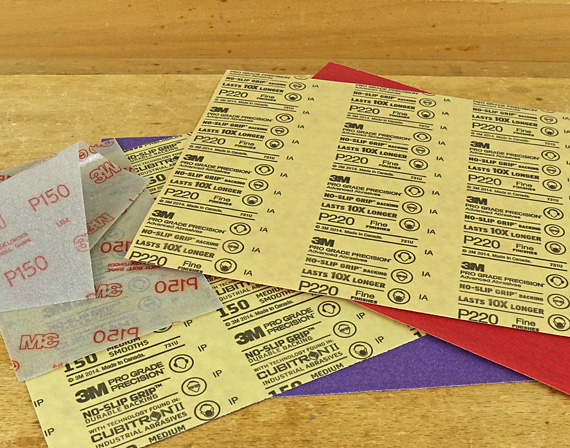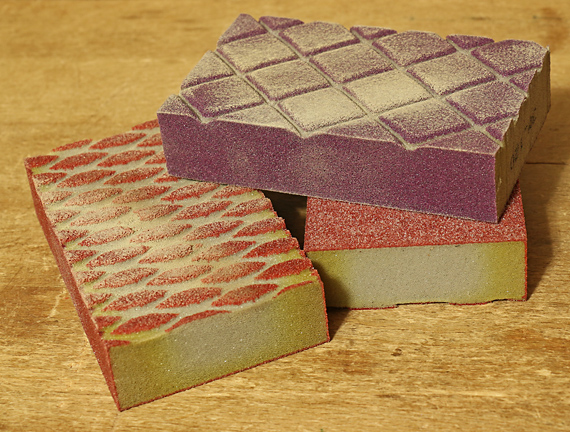
Sanding doesn’t get a lot of respect in the woodworking world, perhaps because it is a rather boring job, and hand planing seems, by contrast, so refined. Nonetheless, sanding is an important step in building many projects, so it pays to take advantage of technological advancements.
3M’s Pro Grade Precision sanding sheets seem to cut faster than any others that I have tried. I can really sense the sharpness of the “proprietary, precision-shaped ceramic mineral” abrasive biting the wood. Of course, this is not a controlled test, but it is enough to make me reach for these sheets first. 3M’s labeling is a bit confusing – this product is an upgrade from their “Pro Grade” paper, which uses aluminum oxide abrasive.
I had reported earlier that I didn’t find the grippy backing of 3M’s sanding sheets particularly helpful, but my experience since then has shown me different. The “No-Slip Grip” backing does grip rectangular cork blocks better than regular paper backing, and makes sanding easier. Even better, it holds very well in the slots of the shop-made, all-cork curved blocks that have become a staple among my tools for curved work. This backing is also significantly more durable than paper backing.
I continue to find 3M’s remarkable Ultra Flexible Sanding Sheets (on the left in the photo above) to be wonderful for working detailed curves. The durability of the film backing and the grit itself far exceed that of paper-backed sanding sheets for this work. They are available in 100, 150, 220, and 320-grit, and in 4 1/2″-wide, 7″-long sheets and 10 1/2-foot rolls.

I previously reported that I hadn’t found any sanding sponges to be useful. I’m still not a big fan, but 3M’s Pro Grade Precision “ultra flexible, dust channeling” sponges are pretty good for smoothing in some sculptural work. An important distinction, sanding sponges do not afford the tactile control, nor do they have the moxie of rasps for shaping. They also break down too fast for their cost. Their main advantage is they are easy to hold as you smoosh them over irregular shapes. Of the two types shown, the larger diamond pattern has been more durable.
You can find all of these products at home center stores. As usual, I relate only my direct shop experience with tools, unsolicited and uncompensated. I just want to help you make things.


Here’s a hearty “I second that” to your endorsement of the Ultra Flexible Sanding Sheets. I found them by accident at a big box store and was instantly mesmerized. I took them home for sanding a batch of spoons – – – I wrap sandpaper around a short length of broomstick, which lets me keep crisp arrises where I want them. The stuff is GREAT! 5 or 6 serving spoons in hard maple and every piece, in every grit, were still like new. Usually I shred the paper-backed Klingspor I’ve been using for years pretty quickly.
Years ago I was discussing dressing and wrapping a (non-woodworking-related) finger injury with a hand surgeon and I told him I was having a hard time with the cheaper store-brand copies of the 3M products that work so well. He said “Don’t even bother. 3M seems to have alien technology that the other guys can’t figure out.” I have found this to be true in general, and this entry is another example.
Thanks for the tips!